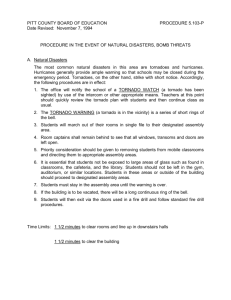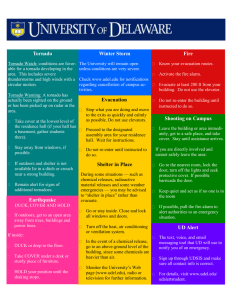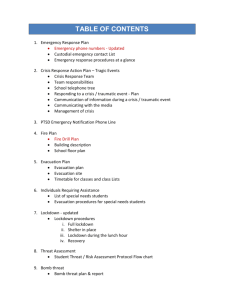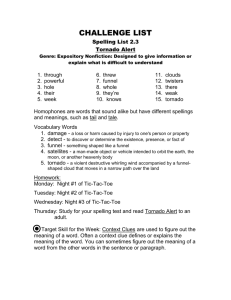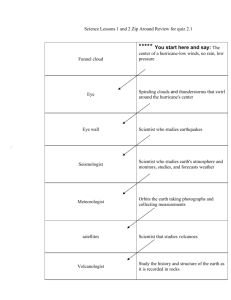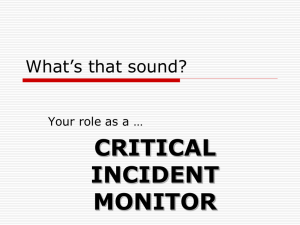EMERGENCY PROCEDURES Do Not Remove The Department of Public Safety
advertisement
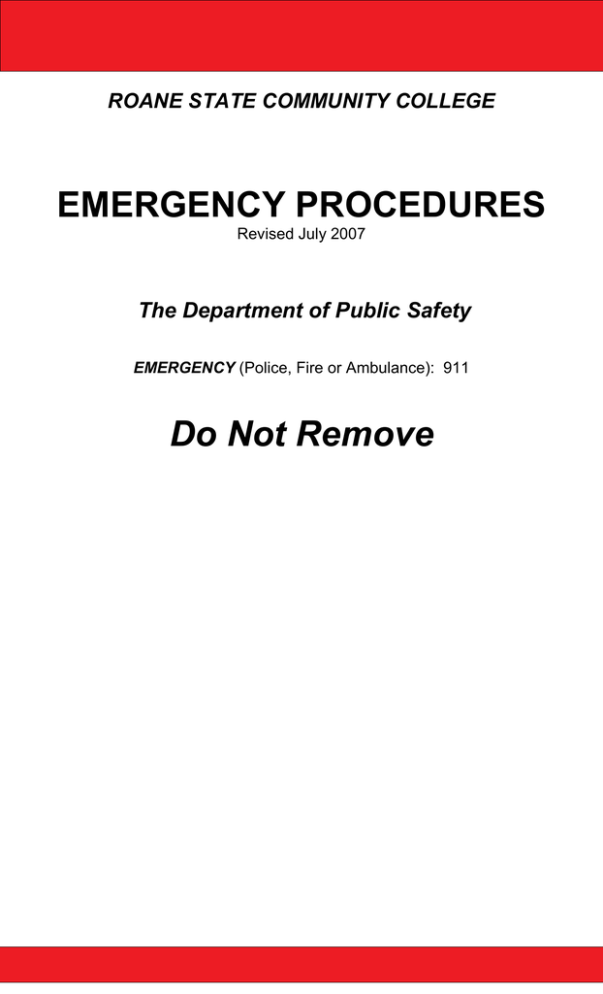
ROANE STATE COMMUNITY COLLEGE EMERGENCY PROCEDURES Revised July 2007 The Department of Public Safety EMERGENCY (Police, Fire or Ambulance): 911 Do Not Remove MEDICAL EMERGENCY ON CAMPUS Minor Injuries/Illnesses Non-life threatening injuries/illnesses should be reported to The Department of Public Safety immediately. The injured or ill individual will be provided with appropriate attention and assistance. Serious Injury/Illness Life threatening injuries are immediately responded to by The Department of Public Safety additionally, emergency medical service (911) should be contacted immediately if life threatening injuries have occurred. The parent/spouse/legal guardian will be notified by The Department of Public Safety without delay. If the medical emergency is a heart attack, there are AED’s placed on each campus in designated areas. MEDICAL EMERGENCY ON CAMPUS BOMB THREAT Most bomb threats are received by telephone. Occasionally, a bomb is placed without notification. Treat any bomb threat as valid and follow the procedures below. 1. If you see a suspicious object or potential bomb, DO NOT HANDLE THE OBJECT. Immediately call The Department of Public Safety. If The Department of Public Safety cannot be reached, call 911. 2. If you receive a bomb threat by telephone, do the following: Transfer the call to The Department of Public Safety If you cannot transfer the call, do the following: a. Write down as much information as possible. If the caller will engage in conversation, ask the following questions. 1) 2) 3) 4) 5) 6) When is the bomb going to explode? Where is the bomb located? Which campus is the bomb located? What kind of bomb is it? What does the bomb look like? Why did you place the bomb? b. Keep talking to the caller as long as possible. Record the following information: 1) 2) 3) 4) 5) 6) c. Time of call. Age and sex of the caller. Speech pattern, accent, possible nationality, or other information about the caller. Emotional state of the caller. Background noises. Telephone number showing on LCD display. When the caller ends the conversation…IMMEDIATELY call The Department of Public Safety to report the incident. If The Department of Public Safety cannot be reached, call 911. d. Conduct a quick search of your office or classroom to check for any suspicious object. Report the location of any suspicious objects to The Department of Public Safety . 1) 2) 3) 4) 5) DO NOT TOUCH ANY OBJECT. Do not open any drawers or cabinets. Do not turn lights on or off. Do not use cell phones or two-way radios. Do not discuss the threat with anyone other than The Department of Public Safety . 3. After receiving notification of a potential bomb, The Department of Public Safety and designated search-team personnel will conduct a systematic search of the building(s). The Department of Public Safety will also interview the person who reported the potential threat. 4. College administrators will make a decision regarding evacuation of Campus buildings. EVACUATE IMMEDIATELY and take personal belongings when an evacuation is ordered. Do not reenter the building until authorized to do so by The Department of Public Safety . BOMB THREAT EVACUATION – FIRE/BOMB THREAT Things to Know BEFORE a Fire: 1. Know the location of your pre-designated emergency assembly point (at least 300 feet away from the building). The assembly points are designated on the evacuation plan posted in each building. 2. When the fire alarm is sounded, College policy requires that all persons evacuate any facility via the nearest available exit to your pre-designated emergency assembly point. 3. Remove personal items when you evacuate; i.e., purses, book bags, etc. 4. Close all doors to classrooms and offices. Leave them unlocked for emergency personnel unless otherwise instructed. 5. Know the location of alarm pull-stations, fire extinguishers, fire exits, and assembly points in your area. 6. Ensure disabled persons gets to a stairwell where then can be transported by emergency personnel. Notify The Department of Public Safety or other emergency personnel of the location of disabled individuals. 7. Do not reenter the buildings until authorized to do so by The Department of Public Safety . In Case of Fire: (See Evacuation Map Posted in Each Building) Evacuate immediately when you hear the fire alarm or an RSCC official tells you to evacuate. Always walk calmly and quickly to the nearest marked exit and your pre-designated assembly point at least 300 feet away from the building. Alert others to do the same. DO NOT USE ELEVATORS! 1. If you see/smell smoke, call The Department of Public Safety immediately. If The Department of Public Safety cannot be reached, call 911. 2. If there is heavy smoke, activate a pull-station alarm, stay low, and evacuate to your pre-designated assembly point. 3. If you see flames, activate a pull-station alarm and evacuate to your pre-designated assembly. Call the Department of Public Safety immediately. If The Department of Public Safety cannot be reached, call 911. 4. If you are trapped, shout at regular intervals to alert rescuers to your location. If a window is available, place an article of clothing in the window as a marker for rescuers. NOTE: DO NOT block fire lanes or hydrants nor interfere with emergency personnel. Notify emergency personnel if anyone is missing from your group. EVACUATION – FIRE/BOMB THREAT UTILITY FAILURE In the event of a utility failure, immediately notify The Department of Public Safety or Maintenance at the numbers listed below. ELECTRICAL/LIGHT FAILURE Emergency building lighting should provide sufficient illumination in corridors and stairs for safe exiting. ELEVATOR FAILURE If you are trapped in the elevator, use the emergency phone or personal cell phone to notify The Department of Public Safety and press the elevator emergency alarm button located on the front panel which will signal for help. PLUMBING FAILURE/FLOODING Cease using all electrical equipment. Notify The Department of Public Safety . If necessary, vacate the area. GAS LEAK Cease all operations. DO NOT SWITCH ON LIGHTS OR ANY ELECTRICAL EQUIPMENT. REMEMBER, electrical arcing can trigger an explosion! Vacate the area. WARNING: DO NOT SOUND THE ALARM or USE ANY PHONES IN THE AREA. After vacating the area then notify The Department of Public Safety. VENTILATION PROBLEM If smoke odors come from the ventilation system, immediately notify The Department of Public Safety. If necessary, cease all operations and vacate the area. The Department of Public Safety Main Campus 865-882-4500 Main campus Maintenance 865-882-4565 EMERGENCY (Police, Fire, or Ambulance): 911 UTILITY FAILURE SEVERE WEATHER – TORNADO The Severe Weather Alert System and Building Coordinators will notify the Campus of dangerous weather. It is prudent that you understand the following weather patterns indicative of a tornado. 1. Tornadoes are unpredictable and difficult to forecast. Either severe thunderstorms or severe atmospheric conditions without the severe thunderstorms can generate tornadoes and lightning. 2. Weather alert radios, weather web sites, and television weather reports will be used by campus personnel to determine the potential for dangerous weather on all campuses. 3. Tornado Situations There are two types of messages issued by the Weather Bureau dealing with tornados: Tornado Watch and Tornado Warning. Each message has a specific meaning and should not be confused with one another. Tornado Watch: Issued to alert persons of the possibility of a tornado development in a specified area for a specific period of time. It is not necessary to interrupt the normal operations of the College during a tornado watch. Tornado Warning: Issued when a tornado has actually been sighted in the area or indicated by radar. Warnings will indicate the location of the tornado, the time of detection, the area through which it is expected to move, and the time period during which the tornado will move through the affected area. When this warning is issued, the College should take immediate safety precautions. 4. Knowledge of the following characteristics of tornados is useful in tornado detection, and tornado preparedness planning. The following are signs of a tornado threat: a. b. c. d. 5. Take the following precautions should you be notified by campus personnel to position yourself for a potential tornado, experience any of the signs of a tornado, or an actual tornado: a. b. c. d. e. f. g. 6. Heavy rains, gusty winds, small hail, large hail, then relatively calm. Tornados are more likely to occur in mid-afternoon, generally between 3 p.m. and 7 p.m., but they have occurred at all times of the day. A distinctive train-like roaring sound when the tornado is a mile or less away. A funnel or anvil shaped cloud. Move away from windows, glass, and/or skylights. Move to an interior hall/wall, a closet, or get under a sturdy table or desk. Move to the lowest floor if possible. Avoid/evacuate gymnasiums, cafeterias, and other large-span roofed areas. Move to an area designated as a severe weather shelter area. These areas have been designated by appropriate signage. Kneel/crouch, head down, hands behind head. Follow any additional instructions that may be provided by building coordinators. Should your location experience a tornado and sustain injuries or property damage, do the following: a. b. c. d. Avoid loose/dangling electrical wires or broken utility lines. Contact 911 emergency services and The Department of Public Safety. Report to your designated evacuation area if safe to do so. If needed, direct emergency personnel to the injured or trapped. Remain at your evacuation area until released by the Emergency Personnel or a Building Coordinator. Follow instructions provided by the Building Coordinators. SEVERE WEATHER - TORNADO INTRUDER/VIOLENT OR CRIMINAL BEHAVIOR The Department of Public Safety provides you with assistance and protection while campus is in operation. . On-Campus Emergencies, Call The Department of Public Safety or if The Department of Public Safety cannot be reached, call 911. 1. It is important that faculty and staff use their best judgment in dealing with crisis situations in order to insure their personal safety and the safety of others. 2. Everyone is asked to assist in making the campus a safe place by being alert to suspicious situations and promptly reporting them. 3. If you are a victim or witness to a crime, you must promptly notify The Department of Public Safety as soon as possible and report the incident. Include the following: a. Nature of incident b. Location of incident c. Description of person(s) involved d. Description of property involved 4. If you observe a criminal act or whenever you observe a suspicious person on campus, immediately notify The Department of Public Safety and report the incident. 5. Assist The Department of Public Safety when they arrive by supplying them with all additional information and asking others to cooperate. 6. Should gunfire or explosives be discharged on campus or should the campus be ordered to lockdown, you should: a. Immediately lock classroom doors, office doors, etc. If for any reason a door cannot be locked, barricade the door using whatever may be available. b. If possible, stay away from windows. c. Take cover immediately using all available concealment. After the disturbance, notify The Department of Public Safety and seek emergency first aid, if necessary. 7. Lockdowns may be communicated by The Department of Public Safety and/or Building Coordinators. Additionally, the campus public address system or air horns may be activated to indicate a lockdown. 8. If you are taken hostage: a. Be patient. Time is on your side. Avoid drastic action. The initial 45 minutes are the most dangerous. Follow instructions and be alert. Don’t make mistakes which could endanger your well-being. b. Don’t speak unless spoken to and then only when necessary. Don’t talk down to the captor who may be in an agitated state. Avoid appearing hostile. Maintain eye contact with the captor at all times, if possible, but do not stare. Treat the captor like royalty. c. Remain calm and be patient. Avoid speculating. Comply with instructions best as you can. Avoid arguments. Expect the unexpected. Be observant. Attempt to establish rapport with the captor. If medications, first aid, or restroom privileges are needed by anyone, say so. The captors in all probability do not want to harm the persons held by them. INTRUDER/VIOLENT OR CRIMINAL BEHAVIOR Emergency Alert Notifications Tornado Alert-The campus public address systems or the megaphone will be utilized in the event of a severe weather warning (proceed to designated emergency shelter) The air horns will be used only in the event of a lockdown Lockdown Alert (Intruder, Violent Behavior) the campus public address system will be utilized to begin lockdown procedures on the Harriman and Oak Ridge campus. All other campuses will utilize the air horns to warn of a lock down alert. Fire Alarm (Exit Building)
